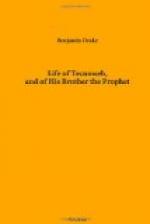In the meantime the earl of Dunmore, having procured boats at fort Pitt, descended the river to Wheeling, where the army halted for a few days, and then proceeded down the river in about one hundred canoes, a few keel boats and perogues, to the mouth of Hockhocking, and from thence over land, until the army had got within a few miles of the Shawanoe camp. Here the army halted, and made a breastwork of fallen trees, and entrenchments of such extent as to include about twelve acres of ground, with an enclosure in the centre containing about one acre. This was the citadel, which contained the markees of the earl and his superior officers.[A] Before the army of Dunmore had reached this point, he had been met by messengers from the Indians suing for peace. General Lewis, in the meantime, did not remain inactive. The day after the battle he proceeded to bury his dead, and to throw up a rude entrenchment around his camp, and appoint a guard for the protection of the sick and wounded. On the succeeding day he crossed the Ohio with his army, and commenced his march through a trackless desert, for the Shawanoe towns on the Scioto. Governor Dunmore, having determined to make peace with the Indians, sent an express to general Lewis, ordering him to retreat across the Ohio. The order was disregarded, and the march continued until the governor in person, met the general and peremptorily repeated it. General Lewis and his troops, burning with a desire of avenging the Indian massacres, and the loss of their brave companions in the late battle, reluctantly obeyed the command of Dunmore; and turned their faces homewards. When the governor and his officers had returned to their camp, on the following day, the treaty with the Indians was opened. For fear of treachery, only eighteen Indians were permitted to attend their chiefs within the encampment, and they were required to leave their arms behind them. The conference was commenced by Cornstalk, in a long, bold and spirited speech, in which the white people were charged with being the authors of the war, by their aggressions upon the Indians at Captina and Yellow creek. Logan, the celebrated Mingo chief, refused to attend, although willing to make peace. His influence with the Indians made it important to secure his concurrence in the proposed treaty. Dunmore sent a special messenger, (colonel John Gibson,) to him. They met alone in the woods, where Logan delivered to him his celebrated speech. Colonel Gibson wrote it down, returned to Dunmore’s camp, read the speech in the council, and the terms of the peace were then agreed on. What those terms were, is not fully known. No copy of the treaty can now be found, although diligent enquiry has been made for it. Burk, in his History of Virginia, says, that the peace was on “condition that the lands on this side of the Ohio should be for ever ceded to the whites; that their prisoners should be delivered up, and that four hostages should be immediately given for the faithful performance of




